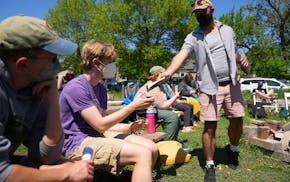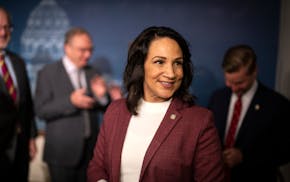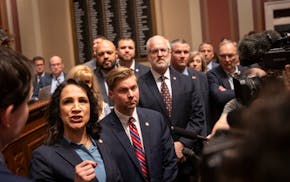Jason Jennette was walking to his University of Minnesota fraternity house just before midnight last month when gunfire rang out in the Dinkytown area, sending him, his friend and other bystanders fleeing for cover.
After scrambling out of sight, Jennette realized a shot had grazed his leg. He said his friend had bullet fragments lodged in his calf. Police say the shooting erupted when a man fired at a woman in a domestic dispute, striking her and four others in the busy Minneapolis neighborhood.
"I was just really concerned … that somebody would shoot into a crowd of people like that in an area I tend to walk through a lot," said Jennette, a U junior studying applied economics. "There was a time I walked everywhere alone … I had never even imagined being robbed or threatened or shot at."
The late-night shooting in the popular Dinkytown commercial hub bordering the U's Twin Cities campus was one of the most jarring examples of a surge in crime near Minnesota's flagship university. A Star Tribune analysis of police department data shows criminal incidents in the neighborhoods surrounding the U reached the highest point in at least a decade this past academic year. From Sept. 1 to May 31, there were about 2,100 criminal incidents reported across university-area neighborhoods, up 40% from the nearly 1,500 tallied in the prior academic year.
The spike near the university came as reported criminal incidents decreased slightly citywide. Violent crimes, such as shootings and homicides, rose across Minneapolis during the same span, however.
Gunfire incidents are far less common in university-area neighborhoods compared with other parts of the city, though some increases are apparent. Thefts make up the bulk of crime in the university area. This past academic year, thefts of vehicles, their parts or contents leapt by about 60%. Robberies doubled in U neighborhoods while aggravated assaults rose by about 20%.
In recent months, a string of more violent crimes cast a spotlight on the area. A boy was killed and a man was injured in a March shooting near Burrito Loco in Dinkytown. Before that, four people were shot in the span of a month at a Dinkytown rental home, which police described as a party house.
Students, parents and neighbors are growing increasingly worried about crime. After the shooting in June, Jennette joined more than 700 people who signed an open letter asking university leaders to work with police to address the problem. Their message conflicted with a vocal faction of students who have called for the university to cut ties with the Minneapolis Police Department and hold U campus officers accountable.
Myron Frans, the U's senior vice president for finance and operations, said the university is taking the problem "very seriously." More officers from the University of Minnesota Police Department and the city have begun patrolling the area, and longer-term crime prevention efforts are in the works, Frans said.
"We consider this to be a very important issue to work on not just for this fall, but today," Frans said.
Dinkytown focus
Of the four neighborhoods surrounding the U's main campus, Marcy-Holmes and Prospect Park are the two growing hot spots, with 60% and 36% increases in reported crimes this past academic year. Those increases rank among the biggest in Minneapolis neighborhoods, according to police incident data.
In Cedar-Riverside, home to the U's West Bank campus, crime stayed relatively flat during the 2020-21 academic year, as did incidents in the Como neighborhood.
The number of criminal incidents on campus grounds decreased by a third this past academic year, according to university police. The on-campus crime decrease came as parts of the U were shut down or operated at reduced capacity during the COVID-19 pandemic.
Police Inspector Todd Loining, of the city's Second Precinct, said the Marcy-Holmes neighborhood, which includes Dinkytown, has become a priority area for the department amid the recent shootings, a rise in car thefts and occasional appearances of drag racers. Suspects have long come there because they view students as easy targets, Loining said. That trend worsened this past year even as fewer students frequented the area.
At the same time, Minneapolis police had fewer officers to deploy to campus neighborhoods. More than 200 officers have retired, resigned or taken medical leave since the killing of George Floyd in May 2020. The Second Precinct no longer has beat officers to assign to Dinkytown, nor does it have a community response team that once investigated suspicious activity and property crimes, Loining said.
"There was a lot of intel and a lot of solid work that was being performed on a daily basis," he said. "We no longer have that presence."
Minneapolis police have increased the number of late-night patrols in Marcy-Holmes since last month's shooting. And the U's police department is paying its officers overtime to help patrol Dinkytown and the surrounding area.
The university may increase the size of its campus police force in response to the rising crime, Frans said. Currently, the department has 56 sworn officers.
"We currently believe that we should," Frans said of adding more officers.
However, U President Joan Gabel recently told the Board of Regents that administrators fully recognize "safety is not accomplished solely through an increased presence of law enforcement."
To that end, the university plans to install additional security cameras in Dinkytown and add more emergency phone boxes that connect students to campus police. The university also is working with the city to improve street lighting in Dinkytown — Frans said the U is willing to help pay for the improvements — and considering creating a safety ambassador program in which citizens would help patrol the Dinkytown area.
Chris Lautenschlager, executive director of the Marcy-Holmes Neighborhood Association, said he welcomes the idea of citizen patrols. "Right now, the only people that are really protecting the Dinkytown business community are the business owners who are there," he said.
Balancing students' concerns
University officials are trying to balance the need to address crime with student concerns about an increased police presence.
Student leaders successfully pushed the university to sever some ties with Minneapolis police immediately after one of its officers killed Floyd. The university stopped contracting with the department for security at large events, such as football games, but Minneapolis and campus officers continued to collaborate on joint patrols and investigations.
There also is tension between some students and campus police. An outside expert the U hired to review its police force found some students feared being harmed by campus officers, while others concerned about crime expressed support for the department.
Abdulaziz Mohamed, the U's undergraduate student body president, said he supports Gabel's approach to improving safety near campus. But if the university expands its police force, Mohamed said, he hopes there will be less demand for Minneapolis officers to patrol near campus.
"If you're increasing size, then you have to look at the need for MPD partnership in the grand scheme of things," he said. "For students, they have more trust in that relationship with [university police] than they would with MPD, considering everything that's happened over the last year and a half."
Ryan Faircloth • 612-673-4234
Jeff Hargarten • 612-673-4642

Want to share info with the Star Tribune? How to do it securely

'Safe recovery sites' would offer syringes, naloxone and more to people using drugs. The plan could be in peril.
New Minnesota GOP leaders seek peace with party's anti-establishment wing

Who is Republican Lisa Demuth, Minnesota's first House speaker of color?

